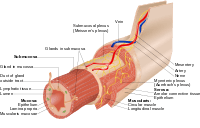Adventitia
 |
| This article is one of a series on the |
| Gastrointestinal wall |
|---|
|
General structure |
|
Specific |
|
Organs |
Adventitia is the outermost connective tissue covering of an organ, vessel, or other structure.[1] It is also called the tunica adventitia[1] or the tunica externa.
For example, the connective tissue that surrounds an artery is called the tunica externa because it is considered extraneous to the artery.
To some degree, its role is complementary to that of the serosa, which also provides a layer of tissue surrounding an organ. In the abdomen, whether an organ is covered in adventitia or serosa depends upon whether it is peritoneal or retroperitoneal:
- intraperitoneal organs are covered in serosa (a layer of mesothelium, the visceral peritoneum)
- retroperitoneal organs are covered in adventitia (loose connective tissue)
In the gastrointestinal tract, the muscularis externa is bounded in most cases by serosa. However, at the oral cavity, thoracic esophagus, ascending colon, descending colon and the rectum, the muscularis externa is instead bounded by adventitia. (The muscularis externa of the duodenum is bounded by both tissue types.) Generally, if it is a part of the digestive tract that is free to move, it is covered by serosa, and if it is relatively rigidly fixed, it is covered by adventitia.
The connective tissue of the gallbladder is covered by adventitia where the gallbladder bounds the liver, but by serosa for the rest of its surface.
See also
References
- 1 2 Editorial Review (June 14, 2012). "Definition of Adventitia". eMedicineHealth. WebMD. Retrieved 2015-03-24.
External links
- Anatomy photo: Digestive/mammal/system1/system10 - Comparative Organology at University of California, Davis - "Mammal, whole system (LM, Low)"
- Histology image: 55_07 at the University of Oklahoma Health Sciences Center (vermiform appendix)